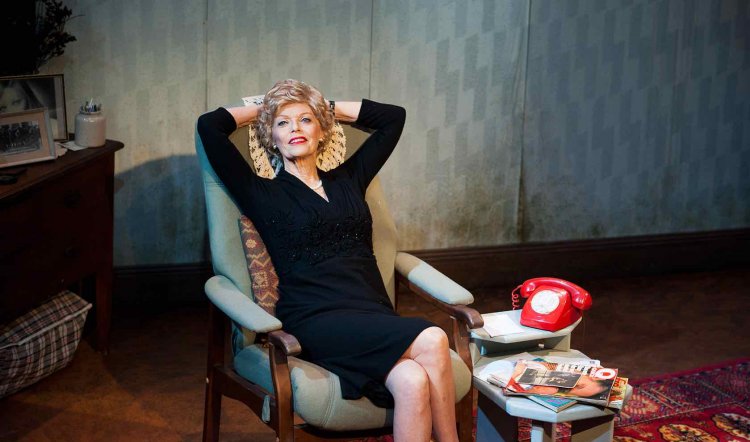
BLONDE POISON
BLONDE POISON, produced by Adam Liberman with Red Line Productions at the Old Fitz; 28 July-15 August 2015. Photography by Marnya Rothe, above and right: Belinda Giblin.
That the true story of Stella Goldschlag is not as well known as the fictitious Sophie of Sophie’s Choice – the novel by William Styron that became a fabled movie starring Meryl Streep – is a mystery because, as always, truth is stranger (and in this instance, more extraordinary) than fiction.
Stella Goldschlag (Belinda Giblin) was a German Jew, whose “Aryan” blue-eyed blondeness enabled her to be safely assimilated in pre-WW2 Berlin and then become the Gestapo’s most notorious “greifer” – catcher of Jews – during the war. Her story was told in 1992 in a book, Stella, by Peter Wyden. He had been her childhood contemporary where she – the most beautiful girl in school – had brusquely brushed aside his declarations of love as only such a goddess would.
Yet, in one of those terrible ironies that could not be made up, with the rise of anti-Semitism and the Nazis, Wyden and his family were able to obtain visas and escape to the USA in 1937 while Goldschlag and her parents failed to do the same. The repudiated boy grew up to be a comfortable and respectable American, while Stella became one of the most reviled and punished figures of her generation.
This 90-minute, one woman play by Gail Louw is based on Wyden’s book and the dialogue includes many of Stella’s verbatim responses to him during an interview in 1992. Blonde Poison – the nickname bestowed on Stella by the Gestapo in honour of her successful fingering of Berlin Jews – takes place in her shabby apartment where she is waiting, smartly dressed and with the best tea things all laid out, for Wyden’s visit.
Her nervousness is infectious as she fiddles and bustles about to fill in the time, calm herself and go over her story in part justification and part defiance. In her past is physical torture by the Gestapo, and mental torture after which she agreed to collaborate in order to save her parents from deportation to Auschwitz. Her offhand and often bitingly sarcastic remarks about these experiences introduce elements of humour that slyly entice the audience to sympathise with her predicament.
Louw is a smarter writer than that, however, and emotional manipulation is minimal and the view almost instantly swings back the other way as Stella reveals herself to be pragmatic, ruthless and unsentimental. This seesaw effect continues throughout the play as she is not a cipher for wickedness or saintliness but is simply a plausibly flawed human being.

Rushing to judgement – to condemn her collaboration – would be hard for most in the way the play is constructed and this makes it compelling and fascinating. Despite her work, Stella’s parents were sent to their deaths, but still she continued to betray Jews to the Gestapo – why? “It was too late by then, don’t you understand? You can’t just stop doing what you’re doing, being what you are, once you’ve gone that far.”
“That far” for Stella was a life of comfort and privilege and relative safety for herself at a time when terror ruled and others were being sent to the gas chambers. Who can say what they would do in similar circumstances? Who can be judge and jury? We cannot know: anything we might say of our own actions has to be hypothetical. And what’s captivating about Stella is the same quality Hannah Arendt famously wrote of in describing Nazi criminal Adolf Eichmann’s inability to take responsibility. What was remarkable, she said, was “the banality of evil”.
And banality is the key. As portrayed by Belinda Giblin in a sustained and intelligent performance that has to be one of the finest of her career, Stella isn’t a monster: she is impossible to pin down or condemn. She is witty, she is vain; she radiates entitlement. She is an ordinary German who happened to be a Jew (inconvenient) and who survived unimaginable privations and torture as well as simple and profound loneliness and heartbreak.
Directed by Jennifer Hagan with sensitivity and finesse, the two women take the dramatic possibilities of the play about as far as is possible given that it would be improved with a cut of 15 minutes of repetition and trivia. That said however, played on an atmospheric set of peeling wallpaper and sad numbers of soft toys (Derrick Cox) with fine sound design (Jeremy Silver) and lighting (Matthew Tunchon) that cleverly meld naturalism and theatrical effect, Blonde Poison is a challenge and fascination for an audience. A “there but for the grace of God go I” thought must go through most minds as Stella lets slip more and more of her story.



